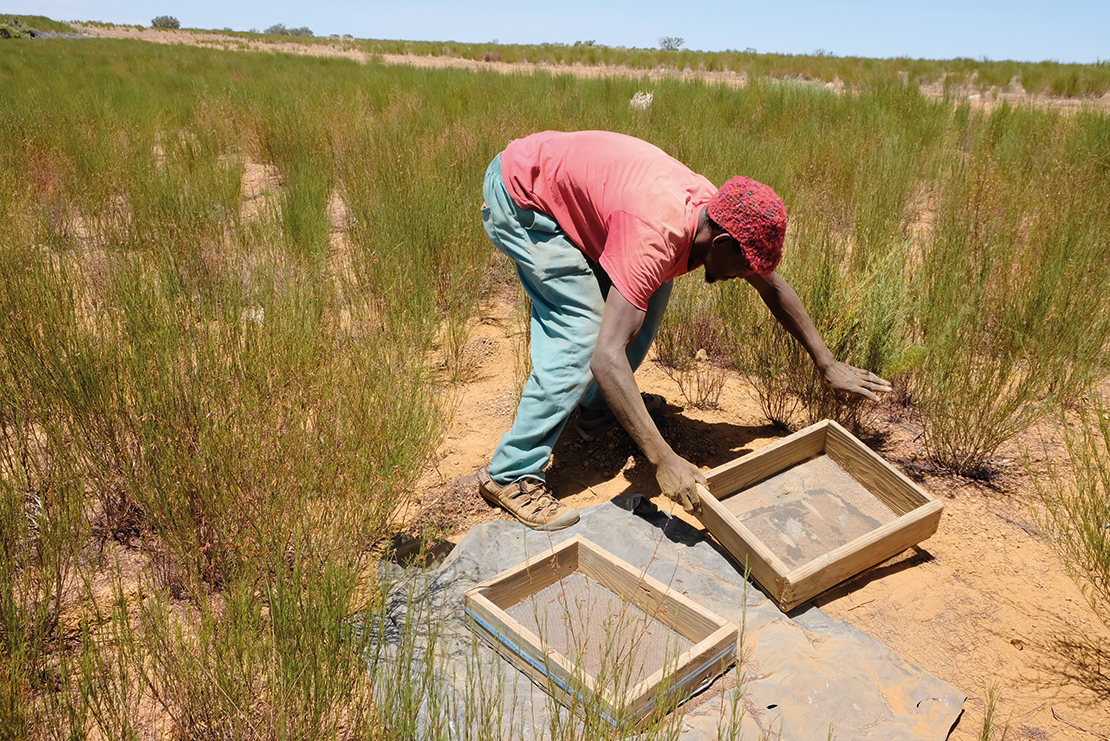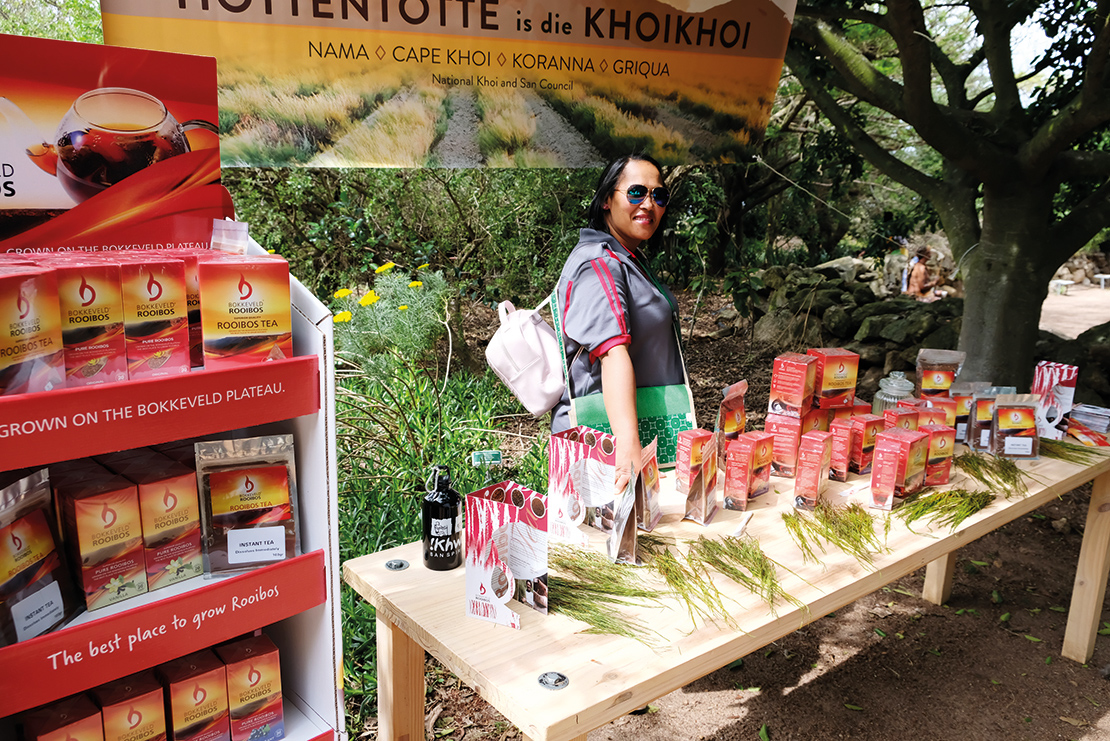
Target 16: Nagoya Protocol in force and operational
By 2015, the Nagoya Protocol on Access to Genetic Resources and the Fair and Equitable Sharing of Benefits Arising from their Utilization is in force and operational, consistent with national legislation.
Key messages
- National implementation of the Nagoya Protocol remains challenging, including the fostering of full and effective participation of IPLCs.
- Adopting a human-rights-based approach to access and benefit-sharing, and embedding the Nagoya Protocol within a holistic post-2020 global biodiversity framework, will bring new opportunities for multiple benefit-sharing arrangements with IPLCs.
- Applying innovative approaches—such as benefit-sharing arising from the use of biological resources and bio-trade— and respecting and enacting legal recognition for diverse community protocols and customary law, opens up potential for increased partnerships between governments, the private sector and IPLCs.

A farmer harvesting rooibos. Credit: Natural Justice.

A family taking a herbal bath. The bath is prepared by boiling leaves, plants and tree bark to create a traditional bath with medicinal properties and a pleasant aroma. The stem of black cardamom (thao qua) is also used in the preparation. Credit: Ian Teh.
Significance of Target 16 for IPLCs
“Indigenous peoples have the right to maintain, control, protect and develop their cultural heritage, traditional knowledge and traditional cultural expressions, as well as the manifestations of their sciences, technologies and cultures, including human and genetic resources, seeds, medicines, knowledge of the properties of fauna and flora, oral traditions, literatures, designs, sports and traditional games and visual and performing arts. They also have the right to maintain, control, protect and develop their intellectual property over such cultural heritage, traditional knowledge, and traditional cultural expressions.
“In conjunction with indigenous peoples, States shall take effective measures to recognize and protect the exercise of these rights.”
— UN Declaration on the Rights of Indigenous Peoples
The Nagoya Protocol goes further than the CBD in spelling out the rights of IPLCs to fair and equitable benefit-sharing, based on mutually agreed terms, arising from the utilisation of genetic resources held by IPLCs and their associated traditional knowledge. The protocol specifies that this includes:
- Rights to prior informed consent, when traditional knowledge associated with genetic resources, is accessed;
- Rights to have their customary laws, community protocols and procedures be taken into account by Parties when implementing their obligations under the protocol;
- Rights to non-restriction of their customary use and exchange of genetic resources and associated traditional knowledge.
The distinct role and contributions of women in access and benefit-sharing processes is also recognised.
IPLCs are responsible for considerable plant and animal biological and genetic diversity. However, implementation of all these provisions leave much to the discretion of governments regarding national legal, policy and administrative arrangements, and how to implement the Nagoya Protocol.
Experience with national implementation reveals a wide latitude of opportunities and risks, with potential outcomes strongly dependent on the meaningful participation of IPLCs in the national operationalisation and implementation of the Nagoya Protocol.1 A national policy framework grounded on a human-rights-based approach to access and benefit-sharing, consistent with international law and respectful of customary norms, provides a strong foundation for realising the benefits for IPLCs as envisioned in the Nagoya Protocol.2
Challenges faced in implementing the Nagoya Protocol
To date, implementation of the Nagoya Protocol has been limited, including the provisions directly relating to IPLCs and where IPLCs have established rights over genetic resources. The COP-MOP decision adopted by the Parties to the Nagoya Protocol identified priorities and practical challenges with respect to IPLCs, including: determining how the concept of “indigenous peoples and local communities” applies at the national level; clarifying the rights of indigenous peoples and local communities over genetic resources and/or traditional knowledge associated with genetic resources; identifying the different groups of indigenous peoples and local communities; understanding the way they are organised; and linking traditional knowledge with the holder(s) of such knowledge.3
The following possible actions were identified: build capacity of Parties and IPLCs with respect to issues of access and benefit-sharing; build on the relevant work of the Working Group on Article 8(j) on the concept of indigenous peoples and local communities; establish national mechanisms for the participation of IPLCs; support coordination and institution building within and among indigenous peoples and local communities to address issues of access and benefit-sharing, including through the development of community protocols; and build capacity to support IPLCs in developing minimum requirements for mutually agreed terms and model contractual clauses for benefit-sharing.
Many of the above-mentioned challenges were carefully addressed by the Rooibos Benefit-Sharing Agreement (see Box 37), which shows how enabling conditions can be put in place, with lessons applicable way beyond the experience of southern Africa.
Box 37
Selling rooibos tea produced by the Khoi-San. Credit: Ivan Vaalbooi.

Case study: The Rooibos Benefit-Sharing Agreement: Breaking new ground with respect, honesty, fairness, and care, South Africa
This is the abstract of a 2019 article by Schroeder et al. published in the Cambridge Quarterly of Healthcare Ethics.4
“The Convention on Biological Diversity (CBD) and its 2010 Nagoya Protocol brought about a breakthrough in global policy making. They combined a concern for the environment with a commitment to resolving longstanding human injustices regarding access to, and use of biological resources. In particular, the traditional knowledge of indigenous communities was no longer going to be exploited without fair benefit sharing. Yet, for 25 years after the adoption of the CBD, there were no major benefit sharing agreements that led to significant funding streams for indigenous communities. This changed with the signing of the Rooibos Benefit Sharing Agreement in South Africa.
— Read the full case study
Contributions and experiences of IPLCs towards Target 16
Experiences from Sri Lanka (see Box 38) and Kenya (see Box 39) demonstrate how IPLCs are using community protocols to reconcile modern legal and institutional systems with customary law systems and procedures in addressing priority concerns in their countries and communities.
Box 38: Association of Traditional Healers for Treatment of Venom Bites and Nirmanee Development Foundation
The Bio-Cultural Protocol highlights the important connections between people and biodiversity in the Kegalle District. Credit: Nuwan Liyanage.

Case study: Bio-cultural protocol of the traditional healers of snake bite, Sri Lanka
The bio-cultural protocol of the Native Healers of the Kegalle District in the Sabaragamuwa Province of Sri Lanka is a comprehensive document covering the intergenerational heritage, traditional medicinal knowledge, their acquaintance with serpents and other animals, and extraordinary treatment methods and varieties of medicine. It describes the unity of nature and the culture, beliefs, values and lifestyles affecting the protection of biodiversity, as well as challenges currently faced by traditional healers, as described in the short, edited excerpt below.
— Read the full case study

Flamingoes on Lake Bogoria. Credit: Gudkov Andrey.
Box 39: Cicilia Githaiga, Programme Manager Traditional Knowledge and Benefit Sharing and Conservation and Customary Use Programmes at Natural Justice, and Eric K. Kimalit, Chair of the Board of the Endorois Welfare Council
Case study: The making of the Endorois people’s bio-cultural protocol, Kenya
The Endorois community live around the shores of Lake Bogoria and other parts of Baringo County, and in Nakuru and Laikipia counties within the Rift Valley of Kenya. We regard Mochongoi Forest and Lake Bogoria as sacred grounds and use them for key cultural and religious ceremonies. The community have been evicted several times from their ancestral home, and their 1973 eviction culminated in the gazetting of Lake Bogoria as a national reserve. The community filed a claim with the African Commission on Human and Peoples’ Rights and succeeded against the Government of Kenya when orders for restitution and compensation were made in 2010.
— Read the full case study
Community protocols are usually holistic and focused on the priorities and concerns of IPLCs based on their needs in specific localities and contexts. Applying innovative, rights-based approaches to benefit-sharing, with legal recognition of diverse community protocols and of customary law, opens potential for increased partnerships between governments, the private sector and IPLCs. Learning from several examples of community protocols developed in Africa, and drawing lessons from them, researchers offer the following conclusions about implementing access and benefit-sharing in Africa:
“… the implementation of ABS [access and benefit-sharing] is made much more meaningful for communities if it takes a broad and strategic view: by giving communities rights over their genetic resources, including obligations for national users in their national ABS frameworks, and linking ABS with biotrade and with options for local and national valorization. From a community perspective, the distinctions of what constitutes utilization in the narrow sense of the Nagoya Protocol, and the separation of traditional knowledge from the use of the resources that it is associated with, can be very artificial.”5
Embedding the Nagoya Protocol within the post-2020 global biodiversity framework opens the opportunity to maximise benefit-sharing arrangements with IPLCs through synergies with other global instruments such as farmers’ rights under the International Treaty on Plant Genetic Resources for Food and Agriculture, the ‘Bio Trade Initiative’ of the UN Conference on Trade and Development, and the UN Sustainable Development Goals, underpinned by a human-rights-based approach, and leaving no one behind.
Opportunities and recommended actions
IPLCs can strengthen their capacity for engaging in access and benefit-sharing arrangements by:
- Identifying community representation and competent authorities;
- Developing processes for agreeing community by-laws and/or community protocols;
- Studying and engaging with national and regional policy and legislative processes, such as the African Union Practical Guidelines for the Coordinated Implementation of the Nagoya Protocol in Africa;
- Seeking legal and technical advice about negotiating with third parties;
- Strengthening community-based monitoring, including participation in national and regional checkpoints.
All users of biological resources and associated traditional knowledge should be informed about and open to negotiate with IPLCs access and benefit-sharing agreements, while conforming with community protocols and national regulations.
Governments, in partnership with IPLCs, should adopt broad-based policy, legal frameworks and guidance consistent with their multiple international obligations, including recognition of IPLC traditional resource rights and associated traditional knowledge. This includes:
- Recognising the rights of IPLCs to their lands, territories and resources and associated traditional knowledge, and ensuring full and effective participation of IPLCs in national processes on access and benefit-sharing;
- Putting in place mechanisms to facilitate equitable benefit-sharing arrangements between IPLCs and users of biological resources and associated traditional knowledge, including access to legal expertise and mediation at all levels in the partnership with IPLCs;
- Agreeing structural, process and outcome indicators to monitor the implementation of the Nagoya Protocol consistent with other global instruments that promote benefit-sharing with IPLCs;
- Promoting legal pluralism and interfaces between local, national and international law, including respect and recognition of community protocols, customary law and customary institutions of indigenous peoples, consistent with the UN Declaration on the Rights of Indigenous Peoples and the UN Declaration on the Rights of Peasants and Other People Working in Rural Areas.
Key resources
- Convention on Biological Diversity (2018) Assessment and review of the effectiveness of the protocol (Article 31). Decision adopted by the parties to the Nagoya Protocol on access and benefit sharing 3/1. CBD/NP/MOP/DEC/3/1. Montreal: Convention on Biological Diversity.
- Tobin, B.M. (2013) ‘Bridging the Nagoya compliance gap: The fundamental role of customary law in protection of indigenous peoples’ resource and knowledge rights’. Law, Environment and Development Journal 9(2).
- Lassen, B., Jansen, L., Rasolojaona, J., Githaiga, C., Fey, L. and Bossou, B. (2018) Community protocols in Africa: Lessons learned for ABS Implementation. Natural Justice and the ABS Capacity Development Initiative. Available at: https://naturaljustice.org/wp-content/uploads/2018/11/2018_Community-Protocols-in-Africa_Lessons-Learned_Natural-Justice.pdf
- Ruiz, M. and Vernooy, R. The custodians of biodiversity: Sharing access to and benefits of genetic resources. London: Routledge.
- Schroeder, D., Chennells, R., Louw, C., Snyders, L., and Hodges, T. (2019). ‘The Rooibos Benefit Sharing Agreement–breaking new ground with respect, honesty, fairness, and care’. Cambridge Quarterly of Healthcare Ethics 29(2), pp. 285–301.
References
- Tobin, B.M. (2013) ‘Bridging the Nagoya compliance gap: The fundamental role of customary law in protection of indigenous peoples’ resource and knowledge rights’. Law, Environment and Development Journal 9(2).
- Ruiz, M. and Vernooy, R. The custodians of biodiversity: Sharing Access to and benefits of genetic resources. London: Routledge.
- Convention on Biological Diversity (2018) Assessment and Review of the Effectiveness of the Protocol (Article 31). Decision adopted by the Parties to The Nagoya Protocol on access and benefit sharing 3/1. CBD/NP/MOP/DEC/3/1. Montreal: Convention on Biological Diversity.
- Schroeder, D., Chennells, R., Louw, C., Snyders, L., and Hodges, T. (2019). ‘The Rooibos Benefit Sharing Agreement – Breaking new ground with respect, honesty, fairness, and care’. Cambridge Quarterly of Healthcare Ethics 29(2), pp. 285–301.
- Lassen, B., Jansen, L., Rasolojaona, J., Githaiga, C., Fey, L. and Bossou, B. (2018) Community protocols in Africa: Lessons learned for ABS implementation. Natural Justice and The ABS Capacity Development Initiative. Available at: https://naturaljustice.org/wp-content/uploads/2018/11/2018_Community-Protocols-in-Africa_Lessons-Learned_Natural-Justice.pdf


